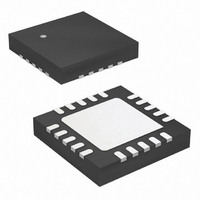ATTINY44-15MZ Atmel, ATTINY44-15MZ Datasheet - Page 144

ATTINY44-15MZ
Manufacturer Part Number
ATTINY44-15MZ
Description
MCU AVR 4K FLASH 15MHZ 20-QFN
Manufacturer
Atmel
Series
AVR® ATtinyr
Datasheet
1.ATTINY44-15MZ.pdf
(225 pages)
Specifications of ATTINY44-15MZ
Package / Case
20-QFN Exposed Pad
Voltage - Supply (vcc/vdd)
2.7 V ~ 5.5 V
Operating Temperature
-40°C ~ 125°C
Speed
16MHz
Number Of I /o
12
Eeprom Size
256 x 8
Core Processor
AVR
Program Memory Type
FLASH
Ram Size
256 x 8
Program Memory Size
4KB (4K x 8)
Data Converters
A/D 8x10b
Oscillator Type
Internal
Peripherals
Brown-out Detect/Reset, POR, PWM, WDT
Connectivity
USI
Core Size
8-Bit
Processor Series
ATTINY4x
Core
AVR8
Data Bus Width
8 bit
Data Ram Size
256 B
Interface Type
SPI, UART
Maximum Clock Frequency
16 MHz
Number Of Programmable I/os
12
Number Of Timers
2
Maximum Operating Temperature
+ 85 C
Mounting Style
SMD/SMT
3rd Party Development Tools
EWAVR, EWAVR-BL
Development Tools By Supplier
ATAVRDRAGON, ATSTK500, ATSTK600, ATAVRISP2, ATAVRONEKIT
Minimum Operating Temperature
- 40 C
On-chip Adc
10 bit, 8 Channel
Lead Free Status / RoHS Status
Lead free / RoHS Compliant
Available stocks
Company
Part Number
Manufacturer
Quantity
Price
Company:
Part Number:
ATTINY44-15MZ
Manufacturer:
ATMEL
Quantity:
1 000
Part Number:
ATTINY44-15MZ
Manufacturer:
ATMEL/爱特梅尔
Quantity:
20 000
- Current page: 144 of 225
- Download datasheet (4Mb)
18.7
18.7.1
144
ADC Noise Canceller
Atmel ATtiny24/44/84 [Preliminary]
Analog Input Circuitry
The ADC features a noise canceller that enables conversion during sleep mode to reduce
noise induced from the CPU core and other I/O peripherals. The noise canceller can be used
with ADC noise reduction and idle modes. To make use of this feature, the following proce-
dure should be used:
Note that the ADC will not be automatically turned off when entering sleep modes other than
idle mode or ADC noise reduction mode. The user is advised to write logical zero to ADEN
before entering such sleep modes to avoid excessive power consumption.
The analog input circuitry for single-ended channels is illustrated in
An analog source applied to ADCn is subjected to the pin capacitance and input leakage of
that pin, regardless of whether that channel is selected as input for the ADC or not. When the
channel is selected, the source must drive the S/H capacitor through the series resistance
(combined resistance in the input path).
The ADC is optimized for analog signals with an output impedance of approximately 10k or
less. If such a source is used, the sampling time will be negligible. If a source with higher
impedance is used, the sampling time will depend on how long the source needs to charge the
S/H capacitor, with can vary widely. The user is recommended to only use low impedant
sources with slowly varying signals, since this minimizes the required charge transfer to the
S/H capacitor.
Signal components higher than the Nyquist frequency (f
distortion from unpredictable signal convolution. The user is advised to remove high-frequency
components with a low-pass filter before applying the signals as inputs to the ADC.
a. Make sure that the ADC is enabled and is not busy converting. Single-conversion
b. Enter ADC Noise Reduction mode (or Idle mode). The ADC will start a conversion
c. If no other interrupts occur before the ADC conversion completes, the ADC inter-
mode must be selected and the ADC conversion complete interrupt must be
enabled.
once the CPU has been halted.
rupt will wake up the CPU and execute the ADC conversion complete interrupt
routine. If another interrupt wakes up the CPU before the ADC conversion is com-
plete, that interrupt will be executed, and an ADC conversion complete interrupt
request will be generated when the ADC conversion completes. The CPU will
remain in active mode until a new sleep command is executed.
ADC/2
) should not be present to avoid
Figure 18-8 on page
7701E–AVR–02/11
145.
Related parts for ATTINY44-15MZ
Image
Part Number
Description
Manufacturer
Datasheet
Request
R

Part Number:
Description:
Manufacturer:
Atmel Corporation
Datasheet:

Part Number:
Description:
Manufacturer:
Atmel Corporation
Datasheet:

Part Number:
Description:
IC MCU AVR 4K FLASH 20MHZ 20-QFN
Manufacturer:
Atmel
Datasheet:

Part Number:
Description:
IC MCU AVR 4K FLASH 20MHZ 14SOIC
Manufacturer:
Atmel
Datasheet:

Part Number:
Description:
MCU AVR 4KB FLASH 20MHZ 14SOIC
Manufacturer:
Atmel
Datasheet:

Part Number:
Description:
MCU AVR 4KB FLASH 20MHZ 20QFN
Manufacturer:
Atmel
Datasheet:

Part Number:
Description:
IC MCU AVR 4K FLASH 15MHZ 14SOIC
Manufacturer:
Atmel
Datasheet:

Part Number:
Description:
IC MCU AVR 4K FLASH 20MHZ 14-DIP
Manufacturer:
Atmel
Datasheet:

Part Number:
Description:
Manufacturer:
Atmel Corporation
Datasheet:

Part Number:
Description:
Microcontrollers (MCU) 512B FL 32B SRAM TIMER ATTINY4 12MHz
Manufacturer:
Atmel

Part Number:
Description:
IC MCU AVR 512B FLASH SOT-23-6
Manufacturer:
Atmel
Datasheet:

Part Number:
Description:
IC MCU AVR 512B FLASH SOT-23-6
Manufacturer:
Atmel
Datasheet:












